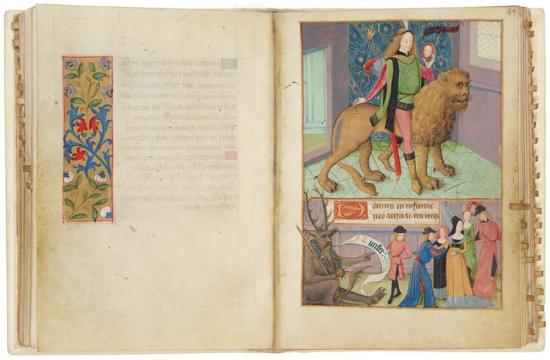
Book of Hours, in Latin
Illuminated by Robinet Testard
Purchased through the Fellows Fund, 1979
Each of this prayer book's Penitential Psalms is illustrated with a personification of a sin to be avoided. The series begins with the first of all sins, Pride, who rides a lion while admiring himself in a mirror. He wears an embroidered green gown with slit sleeves and, under that, a red velvet doublet. His accessories include a headband (with feather), necklace, and studded belt. Thrown over his right shoulder is the black cornet attached to a small gray hat that falls down his back. In the bottom border, Lucifer encourages people to engage in arrogant and pompous behavior.
Late Gothic Vertigo
In the 1460s and '70s fashions reached their Gothic climax. The look for both men and women was tall, long, and lean. Thin was in.
The look for men was dominated by the gown, worn either very short (to the crotch—or barely so) or very long (to the ground). Both versions, accented by a thin belt around a narrow waist, featured high padded shoulders and pleats that flared down over the buttocks and up over the back and chest. These features, developed during the previous decades, brought to a culmination the flatteringly masculine V-shaped silhouette. Pouleines, which accented the lean look, were revived. The chaperon, in fashion for over a hundred years, finally went out of style as new hats–especially a tall, loaf-shaped version—arrived.
Women's gowns continued with their wide V necks, high wasp waist, and long trains. For headgear, temples went out of fashion and were replaced by the turret. This cone-shaped coif, from the tip of which cascaded transparent veils, is perhaps the stereotypical ladies' hat from the late Middle Ages.
